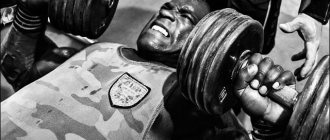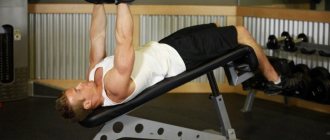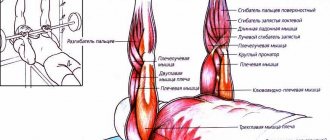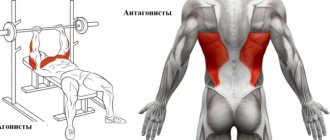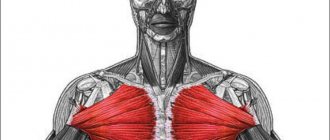Incline bench press is a basic exercise that primarily pumps the pectoralis major muscle, anterior deltoids, triceps and keeps a bunch of auxiliary muscles in tension. Other muscle groups that are under tension are also indirectly involved. The degrees of difficulty are directly related to the weight of the barbell involved. Beginner athletes should limit themselves to using only the bar. Performing an incline bench press even without plates requires proper technique. It is best to exercise under the strict guidance of a trainer or one of your experienced gym mates. This allows you to learn and consolidate the correct movements and easily move on to a more complex version of the exercise - using weights for the bar.
Execution technique
The exercise has the desired effect only when performed correctly. Each phase of the exercise requires careful attention.
Starting position
To take the starting position, you must:
- set the bench at an angle of 30-45 degrees;
- sit on a bench, bring your shoulder blades together, and stick your chest forward;
- while maintaining a bend in the lower back, grab the barbell;
- hands on the bar are slightly wider than the shoulder girdle;
- The barbell is removed from the stand and held with straight arms.
Movement
You need to move according to the following principle:
- inhaling air, the barbell is lowered almost to the upper part of the chest; if it is difficult to hold the bar at a short distance, you can touch the chest with the projectile;
- The barbell is pressed back (exhaling air) until the arms are completely straightened, and then, after a short pause, lowered again.
This movement must be brought to automaticity.
Important Features
Correct execution presupposes that it is impossible:
- Round your back or lift your head and shoulder girdle off the surface of the bench. If you allow this to happen, almost the entire load will fall on your shoulders.
- Set the incline bench to an angle greater than 60 degrees. Changing the slope causes the load on the delta to shift.
- Excessively arch the lumbar region. Otherwise, the back muscles will begin to engage to make lifting easier.
You should immediately take into account these features of the exercise and avoid such deviations.
General recommendations
To master the correct technique, two important points should be taken into account:
- The elbows must be kept strictly under the bar and apart from the body to reduce the load on the triceps.
- Work with a partner when working with too much weight. Otherwise, there is a high risk of injury.
Do not neglect these recommendations.
Close-grip incline bench press
It is a variation of the exercise with a narrow position of the arms. This type of press allows you to reduce the load on the chest and increase the impact on the front deltoids and triceps.
It's the INCLINE PRESS, baby!
Incline barbell press technique
The incline bench press involves heavy compound movements and therefore requires perfect form.
Set the desired bench angle. The barbell is placed on the supports of the rack, weight is added, and it is fixed with clamps. In the starting position, it is preferable for the bar to be directly above the line of the collarbone.
You should not start training with working balance: the first approach is a warm-up.
- Sit on an incline bench, adjusting the seat so that your neck is at eye level.
- When compressed on the bench, the belt should move at the level of the upper pectoral muscle line (or above the upper part of the pectoral muscle). The grip in this exercise is identical to the classic grip when pressing on a horizontal bench. You can also use a wide handle, in which the brushes are as close as possible to the weights, but do not forget that this arrangement of hands on the neck is more traumatic.
- Correct grip means vertical position of the knees at the lowest point of the amplitude. The backrest should be pressed against the back of the bench.
- Inhalation occurs when the bar is overhead at the highest point of the amplitude and is accompanied by a lowering to the chest, and exhalation occurs during the press.
- You should not straighten your arms to the peak of the amplitude until the end, because the triceps are fully involved in the work when the arms are extended. At the bottom of the amplitude, the bar should not touch the chest.
- The important point is to stretch the chest with air. Because of this, the chest muscles stretch during inhalation, which gives better muscle contraction.
General recommendations
To master the correct execution technique, two important points must be taken into account:
- The elbows should be tucked tightly under the bar and out to reduce stress on the triceps.
- Work with a partner when working with too much workload. Otherwise, there is a high risk of injury.
Anatomy of an exercise: which muscles work?
The barbell press, performed on an incline bench, is a variation of the basic classic exercise for developing the chest muscle cell. The atypical position allows you to redistribute the load and use the upper chest to a greater extent, which is naturally much less developed. Performing this exercise allows bodybuilders to give a given muscle group more strength. Consequently, the bodybuilder can develop a more proportional and sculpted chest shape. Incline presses for those involved in strength sports are used as auxiliary exercises and allow them to achieve better results.
The load falls on the following muscle groups:
- clavicular region of the pectoralis major;
- anterior beam - delta;
- pectoralis minor;
- triceps;
- serrated anterior.
Incline Dumbbell Bench Press: Anatomy of the Movement
The dumbbell bench press at an angle is considered a basic exercise. It is multi-joint, because when performing it, the elbow, shoulder and acromioclavicular joints are involved (several joints = basic exercise, one joint = isolation exercise), which together provide the pushing movement of the dumbbells and their lowering.
The correct dumbbell bench press involves working the following muscles:
- pectoralis major (sternocostal and clavicular bundles);
- coracobrachial;
- anterior bundle of deltoid muscle;
- serratus anterior;
- triceps and elbow;
- backs and abs.
Naturally, the target training is aimed at the pectoralis major muscle (which is located mainly in the upper chest), neighboring muscles act as assistants (synergists), and the back and abs stabilize the body when working with free weights.
By the way, I have a detailed article on my blog where I talked about how to pump up the upper pectoral muscles. There I talked in more detail about many cool tricks to make yourself powerful chests.
Preparation for execution
Any workout begins with a warm-up, and then moves on to performing a special block. To do a bench press, you need to properly prepare the muscles that are involved in the exercise - the shoulder rotators, which are the main engines.
Special joint gymnastics allows you to warm up these muscles. Make rotational movements with increasing amplitude. To prepare these muscles, carry out the following steps:
- lightweight approaches to bench press on an inclined bench in a lying position, that is, half of the working first set;
- classic push-ups from the floor surface with your own weight, but without weights.
In pauses between approaches, it is recommended to do stretching movements for the chest - pullovers, dumbbell flyes. Thanks to these exercises, the muscles are relaxed and sets become much more effective in the next approach.
Smith machine barbell press variations
Your position on the Smith machine affects which muscles will be worked during the exercise.
Seated press (classic version) – we work the shoulders and chest muscles
This type of press allows you to work your shoulders.
Before you begin to perform the bench press in a seated position, you need to adjust the back of the bench - it should be tilted from 80 to 85 degrees (almost a vertical angle). The edge of the backrest should be located approximately under the barbell.
- Starting position - sit on the bench so that the bar is located in front of you. The feet are firmly on the floor, the pelvis and back rest against the back of the bench. We grab the bar with a straight wide grip (military grip), elbows pointing to the sides. Rotate the bar to remove it from the hooks and lower it to approximately chin level.
- As you exhale, using the shoulder muscles, press the weight above you, but do not straighten your arms completely.
- While inhaling, we return to the starting position.
- We continue to perform seated presses in the Smith machine until the set is completed.
oh
Beginners are recommended to perform 8 repetitions for each of 3 sets. If this is not your first time doing this exercise, you should do 10 repetitions for 4 sets. Well, for more experienced athletes, 12 repetitions and 4–5 approaches are desirable.
Video: Performing a classic version of the seated press in a Smith machine (lifting the barbell up with a narrow and military grip)
Smith machine incline press
This version of the bench press is performed on an inclined bench at an angle of 30 to 60 degrees. With an incline press, muscle development occurs in the upper chest area.
- Starting position - sit on an inclined bench so that the bar of the barbell is above the upper chest. The feet are firmly planted on a horizontal surface. We put our head on the back of the bench, bringing our shoulder blades together. We grab the bar with a straight wide grip and remove the bar from the hooks.
- As you inhale, gradually lower the barbell until it touches your upper chest.
- As you exhale, squeeze it out, but do not straighten your arms all the way.
- We return to the starting position.
- We continue to perform the bench press until the set is completed.
Squeezing the barbell up is performed exclusively by the shoulder muscles.
Beginners are recommended to perform 3 sets of 8 repetitions, more experienced athletes - 4 sets of 10 repetitions, and professionals can do this exercise for 4-5 sets of 12-15 repetitions each.
Video: Incline bench press in Smith machine
Reverse grip seated press
The main load when performing this exercise falls on the anterior deltoid, the secondary load on the triceps. It is very important to grasp the barbell with a closed grip - when the thumb seems to close the grip, it is not recommended to use a narrow grip to avoid the bar falling on your face. The gymnastic bench should be installed at an angle of 80 degrees.
- Starting position - sit on a bench, rest your back and lower back against the backrest, feet firmly on a horizontal surface. We take the bar with a straight closed grip and remove it from the hooks.
- As you exhale, press the barbell up, but do not straighten your arms all the way.
- As you inhale, lower the barbell until it touches the bottom of your collarbone. Your elbows should move forward a little.
- We continue performing the exercise until the approach is completed.
When performing the reverse grip press, it is very important to use a closed grip to avoid injury.
The number of repetitions and sets varies from 10 to 15 and from 3 to 5, respectively, depending on your level of physical fitness.
Proper execution
Instructions:
- In the starting position, the bar is located above the collarbones. This makes it easier to lift the barbell to the upper chest.
- Raise and lower the projectile in one line, that is, exactly in the vertical direction.
- The shoulder blades are retracted and constantly held in this position. The chest is kept forward during each phase of the movement.
- The inclined version assumes a truncated amplitude. It is not recommended to touch the bar to your chest. Otherwise, there is a risk of injury, since the joints of the shoulders become sharply tense, which makes it difficult to perform a powerful push with the barbell upward. Touching is permissible in cases where specialized presses are performed to develop mobility of the shoulder joint, when minimal weights are used.
- The elbows are kept apart throughout the entire range of motion. They can be brought to the body. This position is also safe, which allows you to increase the degree of triceps involvement.
- The forearms at the lowest point of the movement, when the projectile is located at the upper chest area, are kept parallel to each other. To achieve this, you need to experiment with the width of your grip. This will allow you to choose the best option. Typically, the correct position can be achieved by using a grip when your hands are about 10-15 centimeters wider than your shoulders.
- Forced exhalation should occur at the moment of the press. Inhale while lowering the barbell. You should maintain this breathing rhythm throughout the entire exercise. It is recommended to exhale during the most difficult, difficult stage of the climb. If you exhale too early, the stability of the core will be compromised, which will reduce the power of the effort.
- The negative phase, that is, lowering the apparatus, should be twice as slow as the press.
- At the extreme top point you need to take a short pause. This allows you to improve the load on the chest, as well as improve the stability of the projectile.
INCLINE BAR PRESS! Kock technique!)
Description of the exercise
Bent-over barbell bench press is performed to work out the upper chest; the exercise mostly loads the upper bundle of the pectoral muscle, as well as the frontal (front) parts of the deltoids and triceps.
Initial position
Pre-set the angle of the bench in the range from 35 to 45 degrees. Sit on a bench, place your feet on the floor and press your back against the backrest. Grab the barbell with an overhand grip, placing your hands slightly wider than shoulder-width apart. Remove the barbell from the supports and press it up so that in the top position the barbell is above the middle of your chest.
Trajectory of movement
Take a deep breath and from the top point, lower the barbell to the lower part of the chest, to the highest part of the chest. When lowering, do not touch the chest at the lowest point, stop and, as you exhale, squeeze the projectile up, back towards the middle of the chest. There is no need to pause at the bottom point; we lift the weight to the starting position immediately.
Execution options
A medium and wide grip engages the upper bundle of the pectoralis major muscle. With a narrow grip, the load falls on the middle of the chest and triceps. A wide grip places stress on the side of the chest and reduces the force on the triceps. However, the wider the grip, the greater the risk of injury.
The angle of the bench determines the trajectory of movement. The higher the bench is raised, the greater the load on the pectoralis major muscle. The greater the angle of inclination of the bench, the higher the load on the upper bundle of the pectoralis major muscle; it is most loaded when the angle of inclination of the bench is 30-45 degrees. An angle of inclination exceeding 60 degrees activates the anterior deltoid muscle.
As a starting position, you can use the location of the barbell at the lowest point, the trajectory of movement in this case will be from the bottom to the top point and back, there will be no mistakes here, but lowering the barbell to the chest and pressing up is considered classic, since the barbell usually lies down at the beginning of the exercise on the supports, and is put back at the end of the approach.
Recommendations for implementation
To maximally load the pectoralis major muscle, spread your elbows out to the sides when lowering the barbell. A short press, in which the arms are not fully extended at the elbows, maintains tension in the pectoralis major muscle and reduces stress on the triceps. By using a wider grip and lowering the bar towards your collarbones, you will achieve an even better pumping of your chest muscles.
Basic mistakes
Bench incline too much
The shallower the angle, the lower the load on the target pectoral muscles. The optimal inclination from the horizontal is 30 degrees, which helps to load the triceps. It is not always possible to adjust the position of the bench. If possibilities are limited, it should be taken into account that the maximum permissible angle is 60 degrees. In a high tilt, the shoulder joints experience greater tension, and the emphasis shifts to the deltoid muscle.
Removing the elbows from the projection of the bar
They must be under the bar of the projectile. You cannot move your elbows towards your legs or head.
Using the same weights as the horizontal press
The positive-inclined version assumes that working weights are always taken less than in the classic version. This is due to the fact that the exercise involves an isolated impact on the chest, when the assisting muscles are practically unused.
Spring blows with the bar on the chest
In this version of the barbell press, such a technique is cheating. It makes it easier to lift the working weight, but is unsafe. Hitting the barbell press can cause injury.
Wrist curl
Such a mistake leads to injury. Strict control over the fixation of the palms on the bar allows this to happen. They should always be in line with your forearms.
Lowering the barbell to the center of the chest
A strictly formed movement skill when performing a classic bench press usually leads to such an error. This option requires a change in direction to the collarbone area.
Bear grip
Correct technique involves using a locking overhand grip with the thumb facing the other fingers. This helps make the exercise as safe as possible. The hands should be quite tense at all times. Otherwise, the power of the pressing force will decrease.
Technique
Load distribution
•
The 30-degree barbell press primarily targets the mid-chest muscle group and some of the upper chest. • The bench's 45-degree inclination engages the upper area. • To pump up the lower group of chest muscles, the bent-over barbell bench press is performed in a modification with an upside-down incline.
Elbow position.
When spreading the elbows to the sides, the activity of the triceps decreases, and the work of the pectoral muscle group increases (which are pumped in the exercise). It is permissible in the lower maximum of the press to bring the elbows to the body and spread to the sides.
Hand placement options
• Narrow grip. To reduce the level of load on the thoracic segment and increase the work of the triceps muscle and anterior deltoids, grab the bar with a narrow grip. The range of movement with a narrow grip is maximum. • Wide stance. For maximum pumping of the upper and middle pectoral muscles, use a wide position of your hands on the bar. This modification will reduce the range of motion.
Equipment modifications
• Reverse grip press. • Smith Bench Angle Press Modification. • Using dumbbells. • Angle press in a power rack.
Practical nuances and aspects
To ensure that the bent-over bench press brings maximum results, use these tips:
• The emphasis is not on weight, but on technique. It is better to choose a lower working weight with which you will feel comfortable. • Press your heels or entire foot into the floor. This will increase your hold, stability and emphasis. • Points of contact between the body and the bench: head, both shoulders and shoulder blades, sacrum. • Maintain a natural arch in your back as you press and keep your shoulder blades retracted to minimize the risk of injury. • The higher the angle, the wider the grip. • Lower the bar firmly into the collarbone area, but do not place the barbell on your chest. In this case, a slight movement of the head back is quite acceptable. • Lower the barbell to the widow slower than you raise it. • At the bottom of the exercise, keep your forearms vertical. • Dampen inertia to prevent injury. • When you lie down on the bench, arch your spine and push your chest forward.
Bench press in the general training scheme
First, the main general muscle training is performed, and only after that they begin to load isolated segments of the pectoral muscle group. The incline press is done after basic training, for example, the classic press technique, dips.
How to get the maximum effect from the exercise?
The bench press on an incline bench in a lying position gives maximum results when:
- Before lifting the apparatus, you should try to simply tense your chest muscles, and then focus all your attention on this sensation and record it in your memory.
- Targets the muscles of the chest. The main thing is to avoid imitating a bridge by lifting your lower back off the bench. There should be no gap between the support and the back. Otherwise, muscle work will become significantly more difficult. It is much easier to first perform the exercise on a bench if it has special foot rests.
These two simple rules make this press variation much more effective.
Contraindications
The exercise is not recommended for those who have problems with shoulder joints. When the situation is not critical, the barbell is replaced with dumbbells, which reduce the load. They allow the shoulder joints to move more freely and adapt to the kinematic optimal trajectory of the projectiles.
If an athlete has a back injury, then he must control the deflection in the lumbar region. Following this recommendation allows you to perform this bench press variation, but, of course, with caution.
Contraindications for performing the exercise
Doing bench presses in any form is prohibited for those who:
- Feels pain in the joint area.
- Not fully recovered from the previous workout.
- Suffering from increased cranial pressure.
- I have suffered back injuries in the past.
Old injuries, especially from the spine, can make themselves felt again.
The main column of the body bears a vertical load and therefore it is advisable to consult a doctor before performing it.
How to include an exercise in the program?
This bench press variation is a basic one and should be included in your training. It is recommended to do the exercise in the first half of the lesson. It is best done either as an alternative or after the classic bench press. When it is performed as the main one, the number of repetitions is 6-12 repetitions for 2-4 sets. After heavy exercises, reduce the weight load and do one cycle with 12-15 repetitions.
Decline Barbell Bench Press #DarkFit
Igor September 14, 2018


